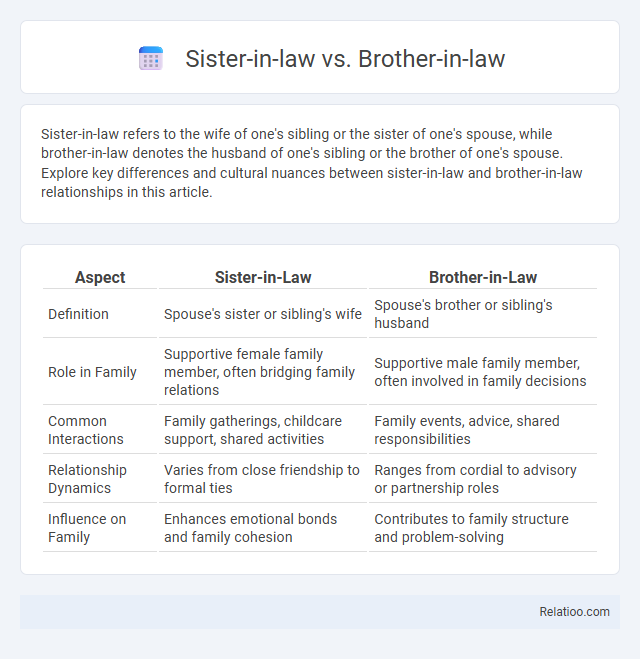Sister-in-law refers to the wife of one's sibling or the sister of one's spouse, while brother-in-law denotes the husband of one's sibling or the brother of one's spouse. Explore key differences and cultural nuances between sister-in-law and brother-in-law relationships in this article.
Table of Comparison
| Aspect | Sister-in-Law | Brother-in-Law |
|---|---|---|
| Definition | Spouse's sister or sibling's wife | Spouse's brother or sibling's husband |
| Role in Family | Supportive female family member, often bridging family relations | Supportive male family member, often involved in family decisions |
| Common Interactions | Family gatherings, childcare support, shared activities | Family events, advice, shared responsibilities |
| Relationship Dynamics | Varies from close friendship to formal ties | Ranges from cordial to advisory or partnership roles |
| Influence on Family | Enhances emotional bonds and family cohesion | Contributes to family structure and problem-solving |
Understanding the Terms: Sister-in-law vs Brother-in-law
Understanding the terms sister-in-law and brother-in-law involves recognizing their specific relationships: a sister-in-law is either your spouse's sister or your sibling's wife, while a brother-in-law is your spouse's brother or your sibling's husband. These distinctions help clarify family dynamics and communication, ensuring you address each relative correctly. Your ability to differentiate these in-law relationships enhances family connections and social interactions.
Historical Context and Cultural Significance
The terms sister-in-law, brother-in-law, and in-law derive from legal and familial bonds established through marriage, reflecting historical kinship systems that extend family networks and social obligations. In many cultures, in-laws play pivotal roles in alliance formation, inheritance rights, and social hierarchy, influencing marriage customs and family dynamics across centuries. These relationships often embody culturally specific expectations and norms, highlighting the intersection of law, tradition, and familial duty in shaping social cohesion.
Roles and Expectations in the Family
Sister-in-law, brother-in-law, and in-law roles differ based on family dynamics and cultural expectations, with sisters-in-law often involved in close emotional support and nurturing relationships, while brothers-in-law may take on protective or advisory roles. Your relationship with these in-laws depends on communication, mutual respect, and understanding boundaries, shaping family cohesion. Expectations typically include participation in family events, offering assistance, and fostering harmony within the family unit.
Key Differences in Relationships
Sister-in-law refers to the wife of your sibling or the sister of your spouse, while brother-in-law denotes the husband of your sibling or the brother of your spouse. In-law is a broader term encompassing all relatives gained through marriage, including both sisters-in-law and brothers-in-law. Understanding these key differences helps clarify your relationships and navigate family dynamics effectively.
Common Challenges and Conflicts
Sister-in-law, brother-in-law, and in-law relationships often face common challenges such as differing family traditions, communication styles, and boundary-setting issues. Conflicts frequently arise from misunderstandings over roles and expectations within family events or decision-making processes. Resolving these tensions requires Your ability to foster open dialogue and mutual respect.
Positive Contributions to Family Dynamics
Sister-in-law, brother-in-law, and in-law relationships each bring unique positive contributions to family dynamics by expanding social support networks and fostering unity through shared experiences and celebrations. Sisters-in-law often enhance emotional bonding and provide nurturing relationships, while brothers-in-law can offer diverse perspectives and strengthen problem-solving within the family. Collectively, in-law connections promote intergenerational understanding and cooperation, enriching family cohesion and resilience.
Navigating Boundaries and Personal Space
Sister-in-law, brother-in-law, and in-law relationships often require clear boundaries to maintain mutual respect and personal space within family dynamics. Understanding individual preferences and communicating openly helps prevent conflicts and fosters harmonious interactions during gatherings or shared living situations. Establishing limits on involvement in personal matters and respecting each other's privacy are key strategies for navigating these extended family connections effectively.
Impact on Marriages and Immediate Family
Sister-in-law, brother-in-law, and in-law relationships greatly influence marriages and immediate family dynamics through emotional support, conflict potential, and boundary navigation. Positive engagement with sisters-in-law and brothers-in-law strengthens family bonds and provides valuable social networks, while unresolved tensions can trigger marital stress and affect household harmony. Understanding roles and respectful communication among in-laws is essential for fostering trust and cohesion within the extended family system.
Tips for Building Healthy In-law Relationships
Building healthy in-law relationships requires clear communication and setting boundaries that respect each other's space and values. You should prioritize empathy and active listening to understand your sister-in-law, brother-in-law, or any in-law's perspective and foster mutual respect. Consistently showing appreciation and maintaining regular positive interactions help create a supportive and harmonious family environment.
Frequently Asked Questions about In-law Roles
In-law roles often cause confusion, especially regarding sister-in-law and brother-in-law distinctions. Your sister-in-law refers to your spouse's sister or your sibling's wife, while your brother-in-law can mean your spouse's brother or your sibling's husband. Frequently asked questions focus on defining these relationships, understanding boundaries, and navigating family dynamics in various cultural contexts.

Infographic: Sister-in-law vs Brother-in-law
 relatioo.com
relatioo.com